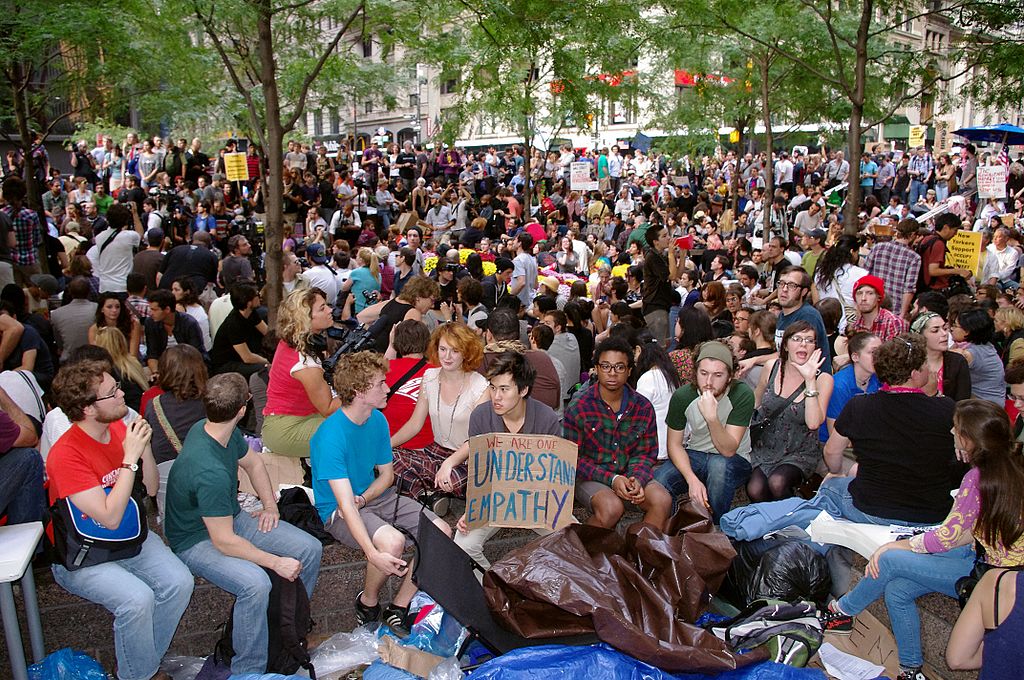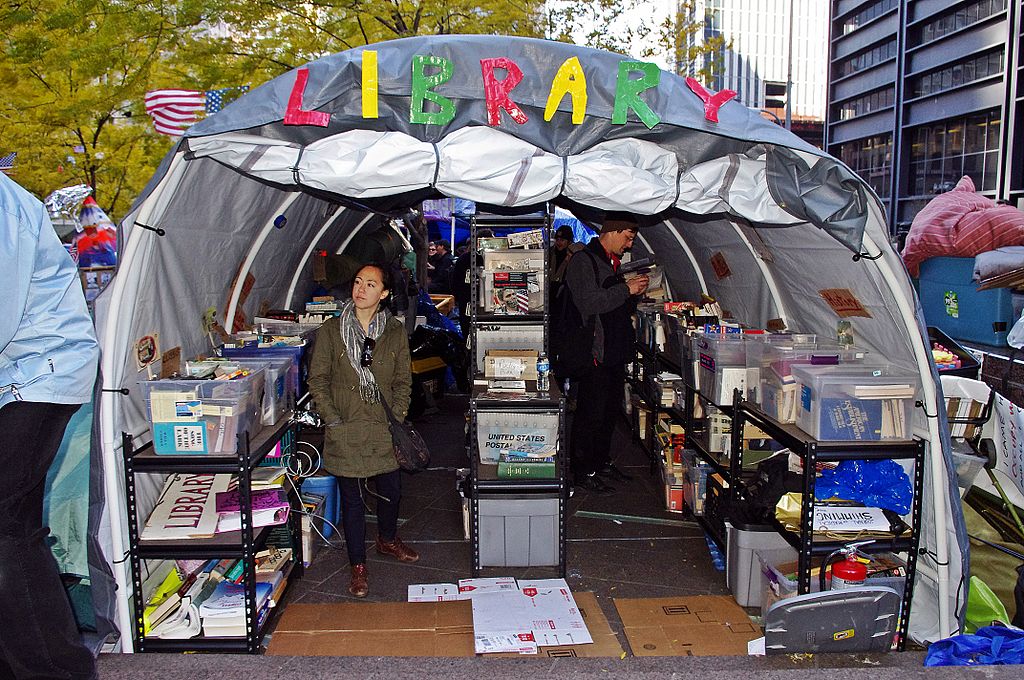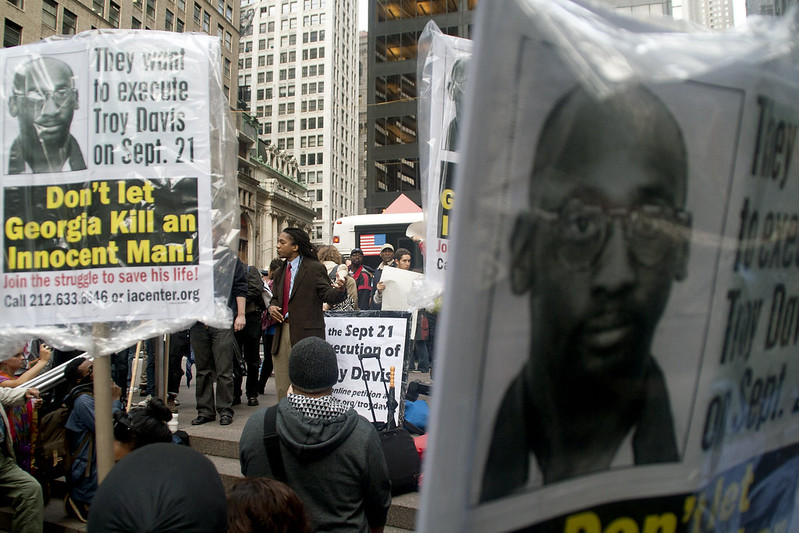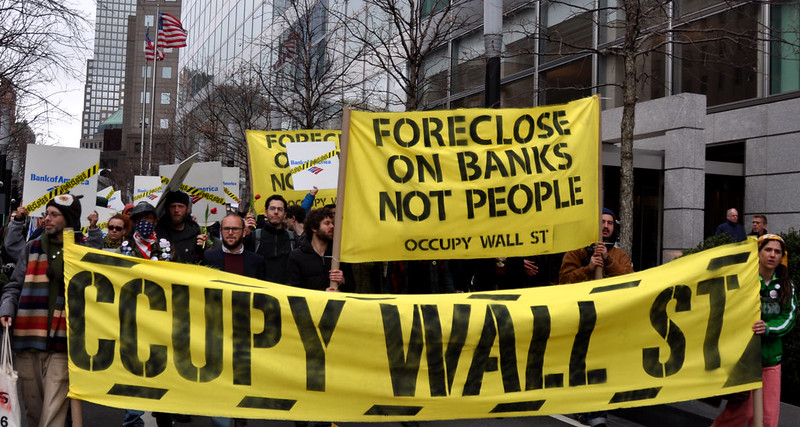
Haley Pessin
Three months before the launch of Occupy Wall Street, I participated in another, smaller occupation called Bloombergville. A dedicated crew of radical activists took over the space across from City Hall and camped out night after night, calling on then-mayor billionaire Michael Bloomberg to address wealth inequality in the city. They raised nearly identical demands to those that would later define the Occupy movement. But dedication was not enough to sustain that occupation, and it fizzled out after 22 days, never topping 150 people.
Three months later, my college photography class took a trip to New York, and a comrade spoke excitedly about visiting a new occupation at the heart of the U.S. financial sector. I was skeptical: we had just done the same thing back in July, and it didn’t go anywhere.
But we didn’t have to go to Occupy Wall Street, because Occupy came to us. Standing in Union Square, I heard a huge roar to my left: several hundred protesters had marched all the way from the occupation to recruit more of us to join. As we followed the march away from the square, a line of cops came running toward us, trapping a section of the march in a bright orange kettle. They began to beat anyone within striking distance, arresting others and roughly dragging them away. I was no stranger to protests, but I had never actually watched cops brutalize demonstrators without any provocation. All I had was my camera. Someone told me to keep snapping.
What I learned from Occupy is that we can’t predict when and where struggles will break out, or which protests will become the start of mass movements. As organizers and activists, we can’t allow ourselves to become jaded because we have experienced more losses than wins; it matters that we remain open when old demands and tactics (in this case, an extremely old labor tactic—occupation) suddenly resonate beyond the radical Left. What’s more, we should not write off people based on the ideas they have today. Consciousness changes through struggle and movements benefit when radicals share their ideas and experience alongside new layers of people who are coming into activity for the first time.
Another fond memory I have of Occupy was visiting the encampment and experiencing so much creativity and ingenuity: the artwork everywhere, the People’s Library, the medic stations, and the mountains of delicious food served by tireless chefs or donated in solidarity. The first time I went, I was reluctant to eat, assuming the meals were best reserved for daily occupiers. But a comrade corrected me: “This food is for everyone.” By reclaiming public spaces, occupiers showed that ordinary people are fully capable of running society ourselves—far better than the 1% who had just crashed the economy, yet faced no consequences and were bailed out at our expense. Masses of people across the country were able to rapidly generalize ideas that previously existed only in socialist and radical circles. Now, reality was confirming those ideas through the practice of thousands of ordinary people, most of whom would not have identified as socialists (back then). It was the first time I heard the chant, “We are unstoppable, another world is possible!” And it felt true.
Sadly, there is a distinct part of the Left today that is totally dismissive of Occupy as having amounted to pointless drum circles, and of social movements more broadly. These assessments miss the significance of Occupy as the first time in many years that people were confident in their own power and used it to defy governments and the police. Most importantly, it popularized the idea that the economic despair of the many has a direct link to the enormous wealth of the few.
It’s also worth recognizing that many of the movement’s weaknesses were informed not merely by subjective factors, but by years without prolonged mass struggle. This also conditioned the consciousness with which people came into the movement, including much greater sympathy toward the police (sometimes even as they were beating us!) than I think anyone on the Left would accept post-Black Lives Matter. Ultimately, the level of struggle during Occupy far outpaced the level of organization needed to sustain and broaden the movement into other areas of life, such as workplaces and communities. This meant that most of the people who participated in Occupy still voted for Obama, the very person who had bailed out the banks. Consider this in light of the fact that it was largely Democrats who sent in the police to violently crush occupations in cities around the country.
The Left still faces the challenge of building the kinds of organizations that can represent a political alternative to the status quo and sustain more militant activity to demand real economic justice—and an entirely different society based on the needs of the many, not profits for the few.
Nevertheless, it is worth emphasizing some of Occupy’s positive lessons because it was one of the first expressions of the more militant action and radical consciousness that has continued to inform U.S. politics—including the popularity of socialism—for the better.

Sherry Wolf
Decades of neoliberal crapification, mounting student debt, and the failed promises of the Obama administration to address inequality finally hit the streets in a way I’d never expected or experienced.
I showed up on the third morning of Occupy and wandered through the scattered occupiers in their sleeping bags and lying out on the pavement, and handed out coffee I bought from the food cart nearby—this was before tents and the well-run established encampment was formed with a kitchen and library. I was immediately struck by the fact that these were mostly young people fighting for their own lives and futures, less of a solidarity movement and more of a burgeoning social rebellion.
Many I spoke to had shitty jobs, no health care, and gobsmacking amounts of student debt. They’d watched the Egyptian Revolution and Wisconsin uprising on their screens, and the notion that they could take action on their own behalf and something good might come of it made sense. Three years into the first Obama administration, it was clear to all of them that “the banks got bailed out while we got sold out,” as the popular chant went.
I have too many memories that capture the politics and spirit of those exuberant two months to choose from. The convergence of the outraged Troy Davis action with Occupy after he was executed by the state of Georgia and NYU students slipped through windows to join us; the mass 5 a.m. mobilization of thousands contacted via urgent texts and emails by the AFL-CIO to protect the occupation in mid-October; the 100 thousand who turned out in Times Square to denounce the police crackdown with soap-box speakers’ voices amplified by the world’s most astonishing human microphone; the national day of solidarity with striking Oakland dockworkers and our action led by Iraq and Afghan vets as marshals; and the urgent 1:15 a.m. text that forced me out of bed to defend the occupation when Bloomberg ordered it torn down and I had to confront the brutality of the NYPD alongside thousands, who had a lesson in the role of the state seared into our memories that night.
But there are small stories that are indicative of the day-to-day wonder of Occupy Wall Street, like when an older Black woman from Harlem came to ask for help getting her building’s heat fixed. A small handful of occupiers decamped to her apartment building and occupied the space there and helped the woman and her neighbors force the landlord to replace the boiler. And when John Carlos, the 1968 Olympian who raised the Black Power fist, spoke to a transfixed crowd of budding radicals—and a few vets—Occupiers soaked up every word and reverently echoed it back to the crowd beyond them.
After the destruction of Occupy, many more young people began to talk seriously about organization and political ideas, and sometimes even joining or forming political parties. As an organized socialist, I certainly saw larger numbers of activists attending meetings and looking for ways to plug in long-term, but more importantly, wanting to understand the world and read left-wing newspapers and books. As creative and effective as Occupy was at identifying the inequality and mobilizing people against the source of the problem—Wall Street, aka, capital—it wasn’t capable of proposing and shaping next steps. Occupy was a social explosion that forged a new wave of militants, struggles, and organizations.

Aaron Amaral
When I remember Occupy, I remember Troy Davis.
After its dramatic explosion onto the scene in September 2011, what could have allowed the Occupy movement to stand up against the coordinated state repression—led by the Obama administration—later that year and throughout 2012? The failure of Occupy to take root amongst the broader working class, and most importantly within communities of color, is a central part of the answer. It is also both a reminder of an historic recurring problem for the Left and a foreshadowing of more recent experiences. (I am referencing here the underwhelming example of the ninety thousand member Democratic Socialists of America’s relationship to the 2020 Black Lives Matter uprising.) But the intersections, relationships, and possibilities run deep.
There is a profound irony here, in looking back on Occupy. While historic causality can be difficult to ascertain and easy to debate, I am convinced that the explosion of the Occupy movement would not have occurred had it not been for the challenge that the anti-racist and anti-death penalty movement brought to the state and the NYPD two days before the singular, most important event for unleashing Occupy.
On September 20, 2011, I joined the NYC march to stop the death penalty execution of Troy Davis in Georgia. Davis was one of hundreds of primarily African American men killed by the state, despite overwhelming evidence of his innocence. My lasting memory of the march was the incredible anger and passion in the outpouring of support for Davis, and the weak police presence as we marched and took the streets. Despite this, Davis was executed the next day.
And thus, on September 22, the day after Davis’ killing, we returned to the streets, with a passion turned to fury. This time, the NYPD asserted themselves in defense of the state’s violence, as only they know how. The demonstration was memorable for this response.
The stunning assaults by a series of NYPD “white shirts” a mere two days later, pepper-spraying young Occupy protesters at the then-nascent—and quite small—encampment has become legendary. In NYC Left circles, the name of Deputy Inspector Anthony “I’d do it again” Bologna lives on in infamy. For anyone paying attention at the time, it was also indisputable that these police actions, more than any other single event, catapulted Occupy into a mass national movement. In my opinion, it is not coincidental that the violence was led by NYPD Commanders. And this type of over-the-top police response, directed from the highest brass, would not have been contemplated had it not been for the days of Troy Davis protests.
So when I recall Occupy, my first thought is the memory of Troy Davis, and the unsuccessful struggle to save his life; and which in its provoking of further state violence and repression helped birth the historic mass movement. And when I recall the trajectory of Occupy, I similarly think of the possibilities should we build a Left in which our anti-racist, abolitionist, and worker-led struggles are, as they should be, at the center of our fight for the 99 percent. There lies the possibility of seeing through the promise of Occupy and the honoring of Troy Davis.

Sean Larson
At about six in the morning on October 14, 2011, I and many others were at Zuccotti Park, locking arms and preparing to physically defend the occupation from eviction. Mayor Bloomberg had demanded the park be cleared by 7 a.m. for bullshit charges of “unsanitary conditions.”
We had over a thousand people, which was huge for so early in the morning, but there were not enough of us, and it was clear we would quickly be arrested and evicted if our numbers didn’t swell drastically by the 7 a.m. deadline. This was so painfully obvious because the police were everywhere, lining every side of the park and filling vans up and down the streets.
The whole time we were receiving a constant stream of live updates on the developing situation, echoing over the people’s microphone in waves of hundreds of voices. Shortly after 6 a.m., somebody ran up and got on the People’s Mic, shouting “I have good news! (good news, good news) The unions are here to back us up! (back us up! back us up!)”
And as those words echoed through the successive waves of the People’s Mic, we watched the police turn around to face literally hundreds upon hundreds of rank and file union workers coming down Broadway, practically in columns, and beginning to take their place on the front lines of the park defense.
The cops took a brief look at the endless column of working-class heroes coming down Broadway, packed their shit up, and ran. What a moment of liberation.
Featured Image Credit: Glen Halog. Modified by Tempest.

